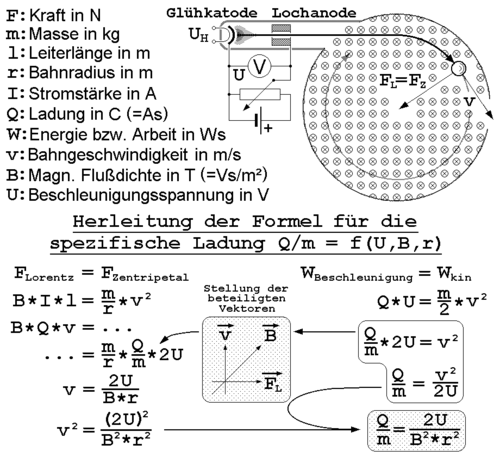Fine beam tube

A fine beam tube is a physical experimental setup in which accelerated electrons in a sphere move on a circular path due to the Lorentz force directed into the interior of the sphere . When they collide with gas molecules, light is generated, which makes the circular path of the electrons visible.
Experimental setup
Some gas (e.g. hydrogen or argon ) is filled into an evacuated glass flask so that the pressure in the flask is low (approx. 0.1–1 Pa). This is measured in such a way that the electrons are slowed down as little as possible by collisions (change in kinetic energy), but the number of collisions is sufficient for a visible glow.
There is an electron gun in the piston . This consists of a heating coil, a cathode and a perforated anode. Electrons emerge from the cathode and are accelerated towards the positively charged anode . Most of the electrons are reabsorbed at the anode, but a small fraction of the electrons leave the gun through a hole in the anode. An ammeter is also connected to the Helmholtz coils to determine the coil current. A voltmeter is connected to the electron gun to adjust the acceleration voltage.
Result
When the heating voltage is switched on, the heating coil heats up and electrons emerge from it. In the electric field between anode and cathode, the electric field acts on the electrons, accelerating them to a high speed, so that some of the electrons leave the anode as an electron beam through a small opening. Since the coil current is not switched on, there is no force on the beam and it maintains its direction. But if the coil current is also switched on, the Lorentz force directs the electrons on a circular path.
Determination of the specific charge of the electron
The higher the coil current, the smaller the radius of the circular path, as the magnetic field becomes stronger. The strength of the magnetic field and the Lorentz force are proportional to one another, so that the Lorentz force also increases. A larger Lorentz force deflects the electrons more strongly, which is why the circular path becomes smaller.
The Lorentz force is always perpendicular to the current direction of movement and, as a centripetal force, enables circular movement. It cannot change the amount of speed and consequently the kinetic energy:
This gives the amount of the specific electron charge
The speed is determined with the help of the law of conservation of energy
That finally follows
The specific electron charge has the value
Since the charge of an electron is accessible from the Millikan experiment , the study of the electrons in the magnetic field serves to determine their mass according to:
Similar concepts for weighing charged particles can be found in the mass spectrometer .
It is valid under the following conditions:
- The magnetic field is homogeneous
- The electrons have zero speed when they exit the cathode













